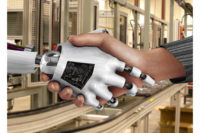Traditionally, robots rely on lots of cabling and connectors. However, continuous the auto industry is developing wireless sensors that are quick, reliable, secure and able to resist interference from existing systems.
Traditionally, robots rely on lots of cabling and connectors. However, continuous cable flexing and tight radius joints eventually lead to failures that require routine maintenance, which can be time consuming and expensive. That’s why the auto industry is developing wireless sensors that are quick, reliable, secure and able to resist interference from existing systems.
The United States Council for Automotive Research LLC (USCAR), a consortium comprised of Chrysler Group LLC, Ford Motor Co. and General Motors Co., has been working with the U.S. Department of Energy’s Savannah River National Laboratory (SRNL) to develop a short-range wireless sensor network and establish an industry standard for similar networks worldwide.
The Big 3 are attempting to leverage shared resources to create needed wireless manufacturing capabilities that don’t exist today. “It’s an opportunity for U.S. automakers to save a lot in manufacturing costs, while developing wireless equipment that meets our requirements and establishes a new standard for all industrial controls,” says Mike Read, Ford lead representative to USCAR’s Manufacturing Plant Floor Controllers Task Force.
The goal is to develop wireless sensors that are reliable, secure, high speed and able to resist interference from existing systems. For example, Read says replacing hard-wired automotive body shop robots with wireless-controlled robots would be a prime application area for a new secure, wireless sensor network.
“Many manufacturing robots require at least six joints, where connecting cables are bending repetitively,” Read points out. “Continuous cable flexing and tight radius joints eventually lead to failures that require routine maintenance. This can be difficult and expensive. Robots with wireless end effectors would eliminate the problem and result in significant cost savings.”
The ability to use wireless, rather than wired, sensors when constructing new assembly plants-or installing new sensors in existing facilities-will also result in considerable cost savings. The long-term goal of the R&D effort is to produce a standard for wireless sensor platforms that can be adopted by the International Society of Automation (ISA).
So far, the SRNL and USCAR engineers have made substantial progress. For instance, they have developed requirements for high-speed, short-range wireless communications and they’re currently testing phase I prototypes.
The SRNL team is focusing on security and is currently testing the system, looking for variability in long-term performance. Meanwhile, the USCAR team is focused on validating the deterministic response time of the high-speed system. According to a spokesperson, “early test results for the phase I prototypes are very promising.”
Get our new eMagazine delivered to your inbox every month.
Stay in the know on the latest assembly trends.
SUBSCRIBE TODAY!Copyright ©2024. All Rights Reserved BNP Media.
Design, CMS, Hosting & Web Development :: ePublishing


